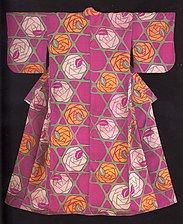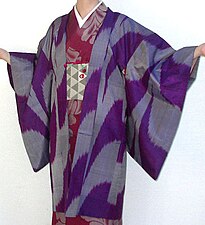Meisen (textile)
This article has multiple issues. Please help improve it or discuss these issues on the talk page. (Learn how and when to remove these messages)
|

Meisen (銘仙, lit. 'common silk stuff') is a type of silk fabric traditionally produced in Japan; it is durable, hard-faced, and somewhat stiff, with a slight sheen,[1]: 79 and slubbiness is deliberately emphasised.[2] Meisen was first produced in the late 19th century,[3] and became widely popular during the 1920s and 30s (late-Taishō to early-Shōwa period), when it was mass-produced[2] and ready-to-wear kimono began to be sold in Japan.[4] Meisen is commonly dyed using kasuri (Japanese ikat) techniques, and features what were then overtly modern, non-traditional designs[5] and colours.[2] Meisen remained popular through to the 1950s.[2]
The fibre used for meisen is staple fibre (often silk noil), degummed and sized with soy milk, which increases durability and increases the depth and brilliance of the dye colours.[3] Between 1910 and 1925 (late Taishō to Shōwa period), the ability to spin[6] as well as weave[2] noil by machine (see tsumugi) was developed into mass production. Prices dropped drastically, and silk cloth and clothing was suddenly within the budget of most Japanese[2] (who had previously worn asa, domesticated bast fibre, or cotton; see tanmono).
Materials, spinning and weaving
[edit]
Silk naturally comes in extremely long filaments (more than a kilometre and a half long), one per silkworm cocoon. Some filaments get broken in processing, or were collected, already broken, from wild.[7] These shorter threads are called silk noil. Traditionally, the long silk was used for high-status garments, often legally reserved for the upper classes, but the lower classes could use noil.[8]
Traditionally, the noil was joined by hand-plying the ends[9][10] or by spinning the noil into thread, as short-staple fibers are spun. Handspun noil was not twisted tightly.[11] Cloth made from noil using Japanese hand methods is called tsumugi.[12] Tsumugi is slubbed, rough-surfaced, soft and drapey, softening further with age.
As the textile industry in Japan industrialized in the late 19th century, large amounts of silk were produced for export.[3] Silk noil was not exported, so there was an abundant supply.[13] Initially, only the filament silk could be made into cloth in a mechanized manner; noil had to be handspun. Attempts were made to machine-spin and machine-weave noil, and techniques gradually improved. These new machine-made slubbed silks were called meisen.[6][2]
Meisen was spun tightly, with many more twists per unit length. It is stiff and crisp, with a glossy, hard, resilient surface, and wears well.[14][15]
Later, cloth made from blends of other fibers, but with similar properties or social roles, was sometimes marketed as meisen.
Dyeing and patterning
[edit]-
Kimono, stencil-printed warp, with a notably Arts and Crafts lattice-and-rose motif, 1912 to 1926
-
Kimono, stencil printed on warp and weft
-
Stencil-printed meisen kimono, chrysanthemum pattern
-
Stencil-printed haori, circa 1920-1940
-
Meisen haori over a more subdued kimono.
-
Kimono with paper cranes (origami), portrayed in Western perspective
Meisen was generally dyed with bright new aniline dyes, which were cheaper and faster to use than traditional plant-based dyes.[2] Unlike in Meiji-period clothing, no attempt was made to match the colours of the older dyes;[4] vivid, obviously synthetic shades were commonly used.[2]
Initially, meisen was produced in plain colours or simple stripes.[13] Later, it came to be dyed by kasuri (Japanese ikat).
While traditional kasuri involved tying bundles of threads and dying them by hand, meisen was often patterned using less labour-intensive techniques. These produced kasuri-style blurred edges to the patterns, but with lower labour costs than hand-tying.[2] For instance, for warp-faced fabrics, the warp threads might be dyed (printed) on the loom,[citation needed] or dyed by the hogushi ("unravelling") technique: weaving the warp with a very sparse, temporary weft (called tane-ito),[3] laying the cloth on a printing-table,[3] stencil-printing the pattern, letting the dye dry, removing the temporary weft, and re-weaving the now-coloured warp threads with a permanent weft.[5][2] Later, techniques for stencil-dyeing the weft threads were invented (yokoso-kasuri), and then techniques for dying both warp and weft (heiyo-kasuri). The dyes were mixed with rice paste or a similar starchy paste before being squeegeed over the stencils.[3]
These thread-dying techniques produce a double-sided pattern,[5] unlike painting or printing cloth, so when a meisen garment begins to show wear on the outside, it can be resewn with the panels flipped inside-to-out.[16]
Patterns on meisen are often somewhat mismatched,[2] and motifs range far beyond traditional kimono subjects.[5] Motifs may be taken from portions of traditional patterns, and are largely abstract, often bold, geometric, or with op-art-like dazzle effects.[3][5] Designs included exotic motifs like stained glass patterns, Egyptian patterns, exotic birds, and exotic flowers like roses and tulips, and were influenced by imported movies.[17] Designs are often Western-influenced, including by the Art Nouveau, Modernist, Expressionist,[17] Art Deco,[5] and Arts and Crafts movements, which had in turn been influenced by Japanese art.[citation needed]

Industry
[edit]The market was highly competitive and had a rapid pace of technical innovation. New designs were produced each season, and advertised as defining specific "looks" and social meanings; department store requested specific patterns, made fashion forecasts, and gave marketing advice. Networks of wholesalers at various geographic scales formed.[17]
After the military, the textile industry lead Japanese industrialisation. Initially, there were government subsidies and substantial government ownership. In 1882, government had just begun to privatise major enterprises, and textile mills made up half of private factories and employed 2⁄3 of factory workers. Textile workers increasingly became mostly female. In the Taishō period, many workers were daughters of well-off farm families and the former ruling class, but later they came mostly from poor peasant families.[17]
-
A store selling meisen, 1930
-
Another Ashikaga advertising poster, 1928; Art Nouveau-influenced pattern[17]
Use and survival
[edit]Meisen was a fairly cheap cloth, used for clothing, noren curtains, futons, and zabuton (cushions).[17][13] In the 1870s, meisen was worn by geisha for informal gatherings.[18]
Meisen garments were often lined with lightweight cloth, from cheaper fibres like cotton or cupro. These were usually not treated with fibre-damaging sizing, as more expensive cloth often was, improving the chances of the garments surviving.[2]
Cheap, bright, hard-wearing meisen kimonos boomed during the economic downturn.[19] It is estimated that, in the late 1920s, over 70% of Japanese women owned one or more.[19]
Meisen was extremely popular in its day, especially among newly-financially-independent women, before abruptly going out of fashion.[2] This abrupt unfashionalbleness helped preserve many meisen garments. Small amounts of meisen are still produced in the 21st century, and there are many meisen garments on the secondhand market. Boldly-patterned meisen is periodically popular with wafuku enthusiasts.[2]
See also
[edit]- Tanmono, the traditional bolt of cloth used for making kimono
- Kasuri, traditional Japanese ikat dyework
- Tsumugi, a rougher, softer, less-uniform slubby noil cloth.
References
[edit]- ^ Dees, Jan (2009). Taishō Kimono: Speaking of Past and Present. Milan: Skira Editore. ISBN 978-88-572-0011-8.
- ^ a b c d e f g h i j k l m n o "Komon and Yukata". Kimono mochi: kimono collection.
The lowly komon kimono is the workhorse of the kimono wardrobe, worn for trips to town, to friends houses, in any situation which is outside of the home but informal. Despite their name, which means 'small design', komon can have large or small imagery, and the repeat can be staggered widely. painted, closely stencilled, woven, Printed, striped, spotted, shibori, silk, jinken, modern polyester--if it's a repetitive design, short-sleeved, and without kamon, then it's a komon. [this quote is given as the title in the metadata]
- ^ a b c d e f g "From the collection of Haruko Watanabe: MEISEN — nancyprice". nancypricestudio.ca. Retrieved 5 April 2022.
- ^ a b "Kimono Mochi: private kimono collection photographs and text". kimonomochi kimono collection. Retrieved 31 July 2021.
- ^ a b c d e f "The Meisen Kimono Exhibit". the ikebana shop. 25 September 2014.
- ^ a b "Khalili Collections | Japanese Kimono | Kimono for a Woman". Khalili Collections.
- ^ Dalby, Liza Crihfield (2001). Kimono : fashioning culture. London: Vintage. p. 156. ISBN 9780099428992.
the cloth that peasants wove for themselves from the broken filaments of wild cocoons after the moths had emerged, or from the leftovers of the cultivated crop that had been spoiled or broken by hatching the seed moths that would lay the eggs for the next season's crop of silkworms.
- ^ Ruth M. Shaver (1966). Kabuki Costume. Tuttle Publishing).
- ^ "Ojiya tsumugi silk". KOGEI JAPAN.
- ^ Dusenbury, Mary (1992). "A WISTERIA GRAIN BAG and other tree bast fiber textiles of Japan". Textile Society of America Symposium Proceedings. Retrieved 12 June 2021.
- ^ "UNESCO - Intangible Heritage Home". ich.unesco.org.
A yarn [sic][for tsumugi] should be spun by hand out of silk floss. A hard twist yarn cannot be used
- ^ "UNESCO - Yuki-tsumugi, silk fabric production technique". ich.unesco.org.
- ^ Dalby, Liza Crihfield (2001). Kimono : fashioning culture. London: Vintage. p. 333. ISBN 9780099428992.
a flat hard-finish silk
- ^ Salz, Anji (4 July 2016). "Chichibu Meisen Museum & Nassen dyeing". SALZ Tokyo.
- ^ a b c d e f g Iwamoto Wada, Yoshiko (1 January 1998). "Starlets and Masters: Meisen Posters Published by the Textile Makers". Textile Society of America Symposium Proceedings. From Creating Textiles: Makers, Methods, Markets. Proceedings of the Sixth Biennial Symposium of the Textile Society of America, Inc. New York, NY, September 23–26, 1998 (Earleville, MD: Textile Society of America, Inc., 1999).
- ^ Dalby, Liza Crihfield (2001). Kimono : fashioning culture. London: Vintage. ISBN 9780099428992.
Whereas in the 1870s striped meisen [...] or, in summer, thin ikat kasuri had been acceptable for a geisha to wear to an informal afternoon gathering, by 1900 such fabrics had become déclassé.
External links
[edit]- Meisen Kimono exhibit at the Anna Leonowens Gallery, Haruko Watanabe's collection Archived 6 June 2015 at the Wayback Machine
- Photogallery of meisen garments from that exhibit: "From the collection of Haruko Watanabe: MEISEN". nancypricestudio.ca. Retrieved 5 April 2022.








![Another Ashikaga advertising poster, 1928; Art Nouveau-influenced pattern[17]](http://upload.wikimedia.org/wikipedia/commons/thumb/9/9c/Poster_of_Ashikaga_Hon-Meisen_by_Kitano_Tsunetomi.jpg/136px-Poster_of_Ashikaga_Hon-Meisen_by_Kitano_Tsunetomi.jpg)